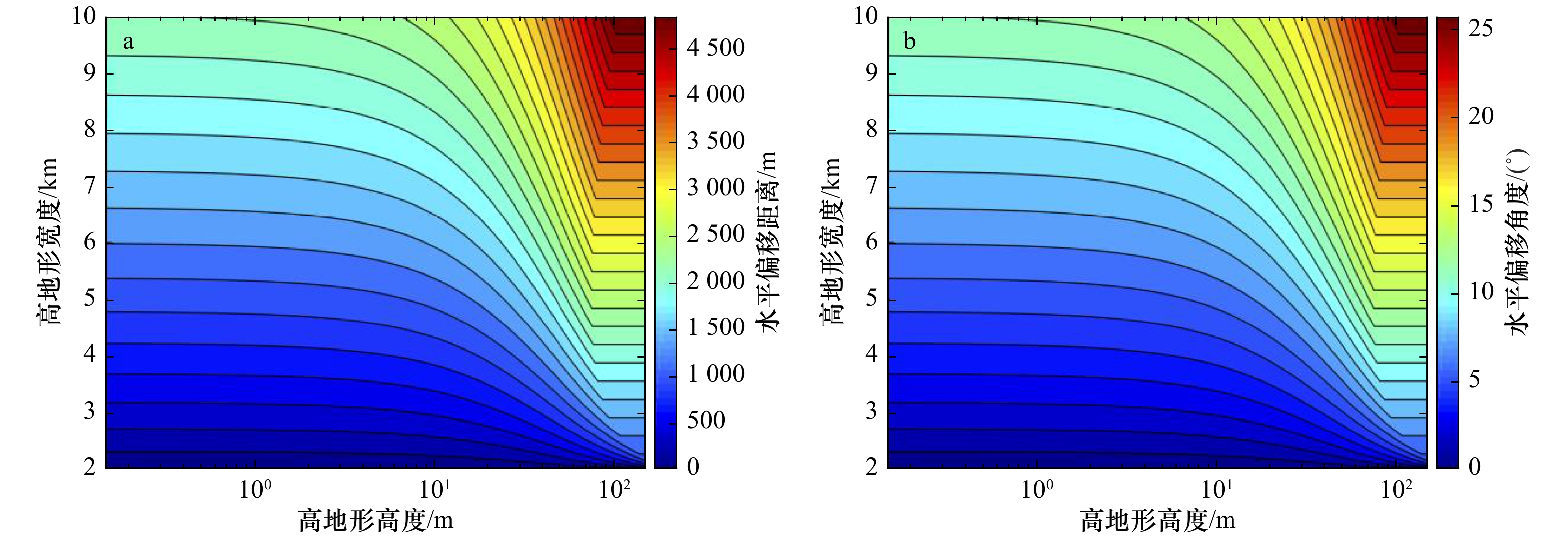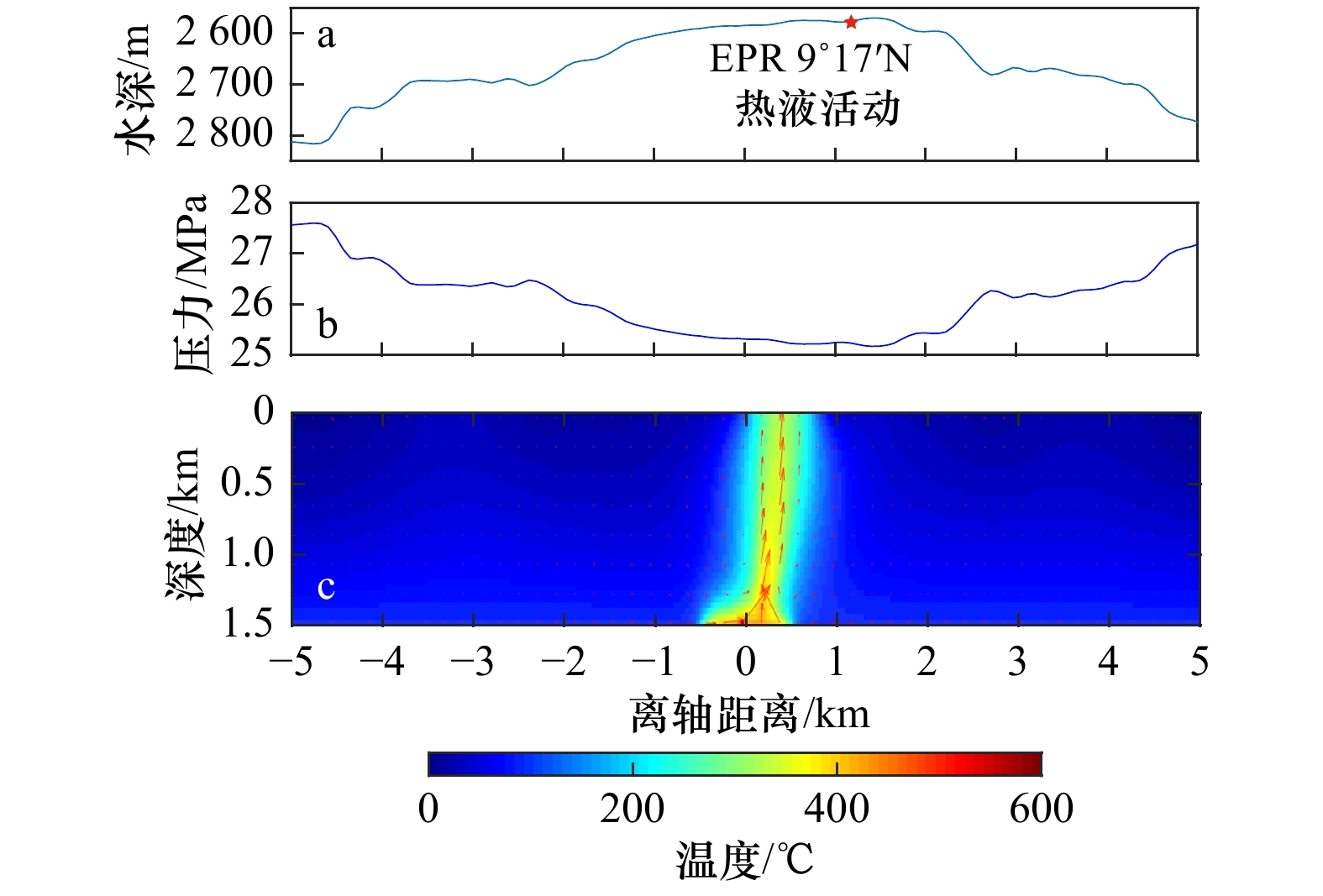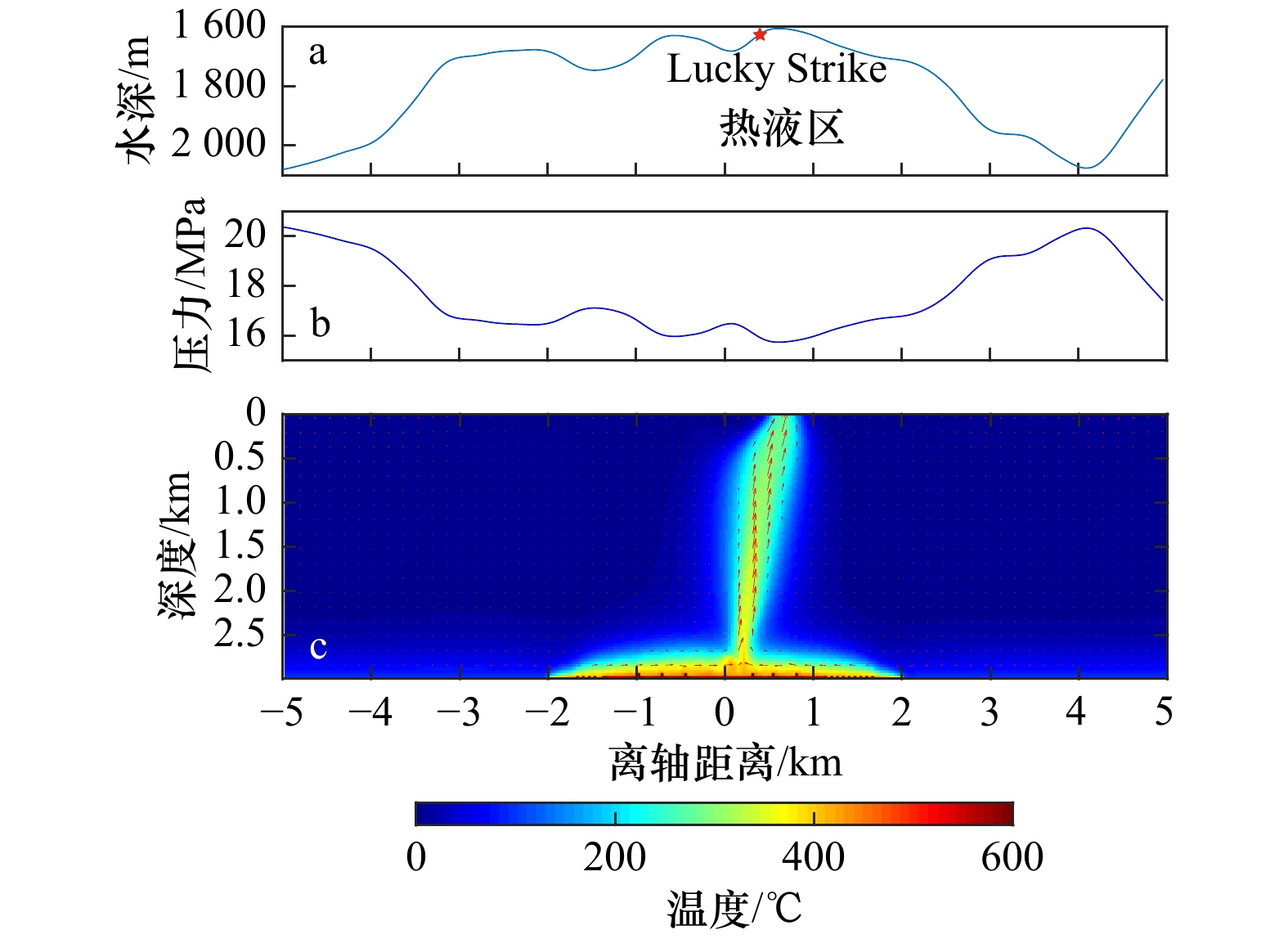Study on the influence of bathymetry on hydrothermal convection under mid-ocean ridges: Based on the spatial variation of overlying pressure of seawater
-
摘要: 洋中脊热液活动多产生于不同扩张速率洋中脊的局部高地形区域,基于达西流体充填的孔隙−弹性热力学模型可以直观、有效地模拟出洋壳内部热液对流的形态、温度结构和喷发位置等信息。数值模拟结果和所得解析模型表明:不同规模的洋底地形起伏会对洋壳内部的热液对流形态产生不同程度的影响,高地形规模越大,起伏程度越大,下伏热液羽向地形高点的偏移就越明显。通过结合东太平洋海隆9°17′N热液区和大西洋洋中脊Lucky Strike热液区实际的跨轴水深分布,也可获得与二者实际喷发位置相吻合的模拟结果。地形起伏相关的洋中脊热液喷发模型揭示洋底低地形及其下伏渗透性洋壳表现为主要的海水充注区域,而高地形由于上覆压力的减小,使其成为汇集热液释放和喷发的主要区域。Abstract: Hydrothermal venting systems mostly develop on the localized bathymetric highs of mid-ocean ridges with different spreading rates, and porous-elastic thermodynamic numerical models, which is filled with Darcian fluid can intuitively model the geometry, temperature structure and venting location of the hydrothermal systems in oceanic crust. Simulation results and the experimental-analytical model reveal that bathymetric highs with different sizes show a varied influence on the geometry of hydrothermal convection, the greater and wider bathymetric highs, the greater deflection of underlying plume to the bathymetric highs. Adopting the cross-axis bathymetry of the EPR 9°17′N and Lucky Strike hydrothermal fields into the model, our simulations produce vents fitting the realistic location of these two fields well. Finally, our schematic model for bathymetric relief deflecting underlying plumes indicates that the lower bathymetry and its underlying porous oceanic crust act as the main recharge zone, while the bathymetric high focuses the most of the discharge hot fluid due to the reduce of the overlying pressure of seawater.
-
Key words:
- hydrothermal convection /
- numerical modelling /
- bathymetric relief /
- seawater pressure /
- Darcy’s law
-
图 2 数值模拟结果
a. 2 000 m×50 m高地形数值模拟结果; b. 2 000 m×100 m高地形数值模拟结果; c. 4 000 m×50 m高地形数值模拟结果; d. 4 000 m×100 m高地形数值模拟结果
Fig. 2 Simulation results
a. Simulation with a bathymetric high of 2 000 m×50 m; b. simulation with a bathymetric high of 2 000 m×100 m; c. simulation with a bathymetric high of 4 000 m×50 m; d. simulation with a bathymetric high of 4 000 m×100 m
图 3 热液羽偏移程度与地形高度的关系
a. 热液羽偏移距离与地形高度的关系; b. 热液羽偏移角度与地形高度的关系
Fig. 3 Relationship between deviation of fluid plumes and height of bathymetric highs
a. Relationship between deviation distance of plumes and height of bathymetric highs; b. relationship between deviation degree of plumes and height of bathymetric highs
图 5 基于EPR 9°17′N热液区地形剖面的数值模拟结果
a. EPR 9°17′N热液区跨轴剖面; b. 基于水深剖面计算的海水压力剖面; c. 稳态数值模拟结果,离轴距离为0代表洋脊轴的位置
Fig. 5 Simulation result based on the bathymetric profile of the EPR 9°17′N vent
a. Cross-axis profile of EPR 9°17′N vent; b. calculated seawater pressure profile; c. running result in steady-state, distance=0 means the location of ridge axis
图 6 基于Lucky Strike热液区地形剖面的数值模拟结果
a. Lucky Strike热液区跨轴剖面; b. 基于水深剖面计算的海水压力剖面; c. 稳态数值模拟结果,离轴距离为0代表洋脊轴的位置
Fig. 6 Simulation result based on the bathymetric profile of the Lucky Strike vent
a. Cross-axis profile of Lucky Strike vent; b. calculated seawater pressure profile; c. running result in steady-state, distance = 0 means the location of ridge axis
-
[1] Stein C A, Stein S. Constraints on hydrothermal heat flux through the oceanic lithosphere from global heat flow[J]. Journal of Geophysical Research: Solid Earth, 1994, 99(B2): 3081−3095. doi: 10.1029/93JB02222 [2] Elderfield H, Schultz A. Mid-ocean ridge hydrothermal fluxes and the chemical composition of the ocean[J]. Annual Review of Earth and Planetary Sciences, 1996, 24(1): 191−224. doi: 10.1146/annurev.earth.24.1.191 [3] Morgan J P, Chen Y J. The genesis of oceanic crust: magma injection, hydrothermal circulation, and crustal flow[J]. Journal of Geophysical Research: Solid Earth, 1993, 98(B4): 6283−6297. doi: 10.1029/92JB02650 [4] Lowell R P, Germanovich L N. Hydrothermal processes at mid-ocean ridges: results from scale analysis and single-pass models[M]//German C R, Lin J, Parson L M. Mid-Ocean Ridges: Hydrothermal Interactions Between the Lithosphere and Oceans. Washington, DC: American Geophysical Union, 2004, 148: 219−244. [5] Lowell R P, Gosnell S, Yang Y. Numerical simulations of single-pass hydrothermal convection at mid-ocean ridges: effects of the extrusive layer and temperature-dependent permeability[J]. Geochemistry, Geophysics, Geosystems, 2007, 8(10): Q10011. [6] Lowell R P, Farough A, Hoover J, et al. Characteristics of magma-driven hydrothermal systems at oceanic spreading centers[J]. Geochemistry, Geophysics, Geosystems, 2013, 14(6): 1756−1770. doi: 10.1002/ggge.20109 [7] Coumou D, Driesner T, Geiger S, et al. The dynamics of mid-ocean ridge hydrothermal systems: splitting plumes and fluctuating vent temperatures[J]. Earth and Planetary Science Letters, 2006, 245(1/2): 218−231. [8] Coumou D, Driesner T, Heinrich C A. The structure and dynamics of mid-ocean ridge hydrothermal systems[J]. Science, 2008, 321(5897): 1825−1828. doi: 10.1126/science.1159582 [9] Driesner T. The interplay of permeability and fluid properties as a first order control of heat transport, venting temperatures and venting salinities at mid-ocean ridge hydrothermal systems[J]. Geofluids, 2010, 10(1/2): 132−141. [10] German C R, Baker E T, Mevel C, et al. Hydrothermal activity along the southwest Indian Ridge[J]. Nature, 1998, 395(6701): 490−493. doi: 10.1038/26730 [11] Lowell R P. Topographically driven subcritical hydrothermal convection in the oceanic crust[J]. Earth and Planetary Science Letters, 1980, 49(1): 21−28. doi: 10.1016/0012-821X(80)90145-4 [12] Wang H Q, Hsieh Y P, Harwell M A, et al. Modeling soil salinity distribution along topographic gradients in tidal salt marshes in Atlantic and Gulf coastal regions[J]. Ecological Modelling, 2007, 201(3/4): 429−439. [13] Bani-Hassan N, Iyer K, Rüpke L H, et al. Controls of bathymetric relief on hydrothermal fluid flow at mid-ocean ridges[J]. Geochemistry, Geophysics, Geosystems, 2012, 13(5): Q05002. [14] Toomey D R, Purdy G M, Solomon S C, et al. The three-dimensional seismic velocity structure of the East Pacific Rise near latitude 9°30′ N[J]. Nature, 1990, 347(6294): 639−645. doi: 10.1038/347639a0 [15] Haymon R M, Fornari D J, Edwards M H, et al. Hydrothermal vent distribution along the East Pacific Rise crest (9°09′–54′ N) and its relationship to magmatic and tectonic processes on fast-spreading mid-ocean ridges[J]. Earth and Planetary Science Letters, 1991, 104(2/4): 513−534. [16] Langmuir C, Humphris S, Fornari D, et al. Hydrothermal vents near a mantle hot spot: the Lucky Strike vent field at 37°N on the Mid-Atlantic Ridge[J]. Earth and Planetary Science Letters, 1997, 148(1/2): 69−91. [17] Singh S C, Crawford W C, Carton H, et al. Discovery of a magma chamber and faults beneath a Mid-Atlantic Ridge hydrothermal field[J]. Nature, 2006, 442(7106): 1029−1032. doi: 10.1038/nature05105 [18] Tolstoy M, Waldhauser F, Bohnenstiehl D R, et al. Seismic identification of along-axis hydrothermal flow on the East Pacific Rise[J]. Nature, 2008, 451(7175): 181−184. doi: 10.1038/nature06424 [19] Crone T J, Wilcock W S D. Modeling the effects of tidal loading on mid-ocean ridge hydrothermal systems[J]. Geochemistry, Geophysics, Geosystems, 2005, 6(7): Q07001. [20] Beaulieu S E, Baker E T, German C R, et al. An authoritative global database for active submarine hydrothermal vent fields[J]. Geochemistry, Geophysics, Geosystems, 2013, 14(11): 4892−4905. doi: 10.1002/2013GC004998 [21] Ryan W B F, Carbotte S M, Coplan J O, et al. Global multi-resolution topography synthesis[J]. Geochemistry, Geophysics, Geosystems, 2009, 10(3): Q03014. [22] Olive J A, Crone T J. Smoke without fire: how long can thermal cracking sustain hydrothermal circulation in the absence of magmatic heat?[J]. Journal of Geophysical Research: Solid Earth, 2018, 123(6): 4561−4581. doi: 10.1029/2017JB014900 [23] Turcotte D L, Schubert G. Geodynamics: Application of Continuum Physics to Geological Problems[M]. New York: John Wiley & Sons, 1982: 22−45. [24] Pitzer K S, Peiper J C, Busey R H. Thermodynamic properties of aqueous sodium chloride solutions[J]. Journal of Physical and Chemical Reference Data, 1984, 13(1): 1−102. doi: 10.1063/1.555709 [25] Anderko A, Pitzer K S. Equation-of-state representation of phase equilibria and volumetric properties of the system NaCl-H2O above 573 K[J]. Geochimica et Cosmochimica Acta, 1993, 57(8): 1657−1680. doi: 10.1016/0016-7037(93)90105-6 [26] Holzbecher E O. Modeling Density-Driven Flow in Porous Media: Principles, Numerics, Software (Vol. 1)[M]. Berlin Heidelberg: Springer, 1998: 213−220. [27] Fontaine F J, Wilcock W S D. Two-dimensional numerical models of open-top hydrothermal convection at high Rayleigh and Nusselt numbers: implications for mid-ocean ridge hydrothermal circulation[J]. Geochemistry, Geophysics, Geosystems, 2007, 8(7): Q07010. [28] Fisher A T. Permeability within basaltic oceanic crust[J]. Reviews of Geophysics, 1998, 36(2): 143−182. doi: 10.1029/97RG02916 [29] Fisher A T. Rates of flow and patterns of fluid circulation[M]//Davis E E, Elderfield H. Hydrogeology of the Oceanic Lithosphere. Cambridge: Cambridge University Press, 2004: 339−377. [30] Fontaine F J, Olive J A, Cannat M, et al. Hydrothermally-induced melt lens cooling and segmentation along the axis of fast-and intermediate-spreading centers[J]. Geophysical Research Letters, 2011, 38(14): L14307. [31] Kent G M, Harding A J, Orcutt J A. Distribution of magma beneath the East Pacific Rise between the Clipperton transform and the 9°17′N Deval from forward modeling of common depth point data[J]. Journal of Geophysical Research: Solid Earth, 1993, 98(B8): 13945−13969. doi: 10.1029/93JB00705 [32] Van Ark E M, Detrick R S, Canales J P, et al. Seismic structure of the Endeavour Segment, Juan de Fuca Ridge: correlations with seismicity and hydrothermal activity[J]. Journal of Geophysical Research, 2007, 112(B2): B02401. [33] Rea D K, Scheidegger K F. Eastern Pacific spreading rate fluctuation and its relation to Pacific area volcanic episodes[J]. Journal of volcanology and Geothermal Research, 1979, 5(1/2): 135−148. [34] Toomey D R, Solomon S C, Purdy G M. Tomographic imaging of the shallow crustal structure of the East Pacific Rise at 9° 30′ N[J]. Journal of Geophysical Research: Solid Earth, 1994, 99(B12): 24135−24157. doi: 10.1029/94JB01942 [35] Shank T M, Fornari D J, Von Damm K L, et al. Temporal and spatial patterns of biological community development at nascent deep-sea hydrothermal vents (9°50′ N, East Pacific Rise)[J]. Deep-Sea Research Part II: Topical Studies in Oceanography, 1998, 45(1/3): 465−515. [36] Baker E T, Chen Y J, Morgan J P. The relationship between near-axis hydrothermal cooling and the spreading rate of mid-ocean ridges[J]. Earth and Planetary Science Letters, 1996, 142(1/2): 137−145. [37] Cannat M, Briais A, Deplus C, et al. Mid-Atlantic Ridge–Azores hotspot interactions: along-axis migration of a hotspot-derived event of enhanced magmatism 10 to 4 Ma ago[J]. Earth and Planetary Science Letters, 1999, 173(3): 257−269. doi: 10.1016/S0012-821X(99)00234-4 [38] Fouquet Y, Ondréas H, Charlou J L, et al. Atlantic lava lakes and hot vents[J]. Nature, 1995, 377(6546): 201. doi: 10.1038/377201a0 [39] Barreyre T, Olive J A, Crone T J, et al. Depth-dependent permeability and heat output at basalt-hosted hydrothermal systems across mid-ocean ridge spreading rates[J]. Geochemistry, Geophysics, Geosystems, 2018, 19(4): 1259−1281. doi: 10.1002/2017GC007152 -





 下载:
下载:






